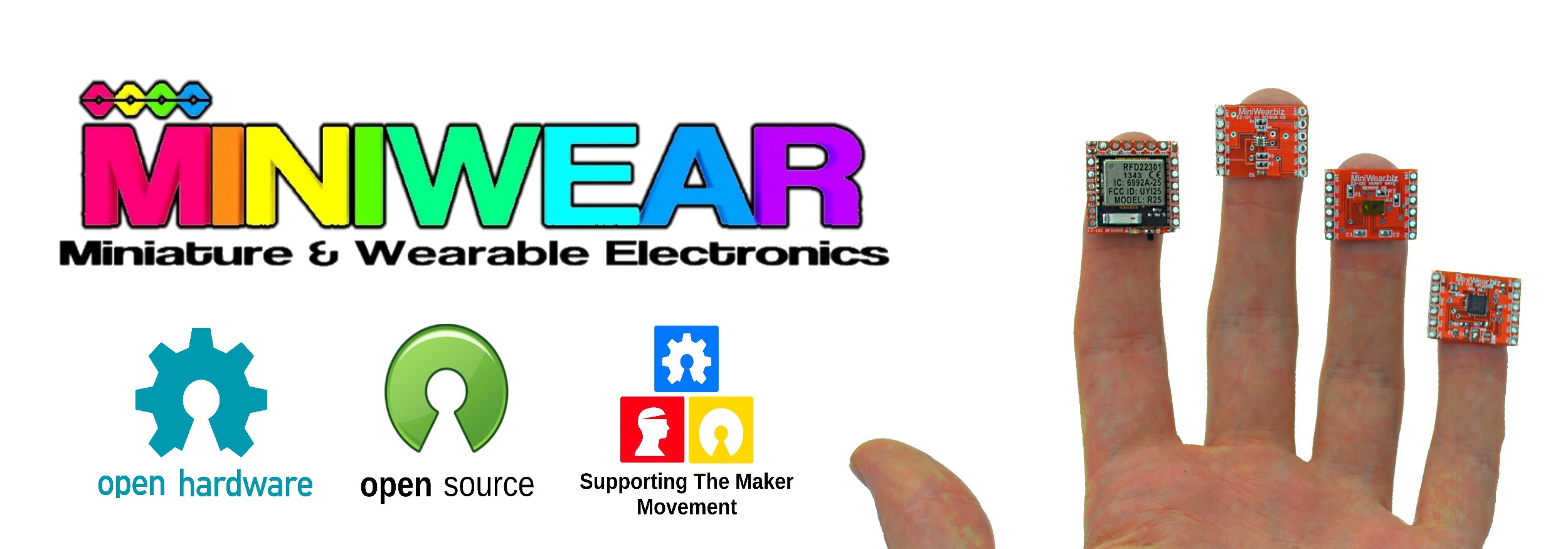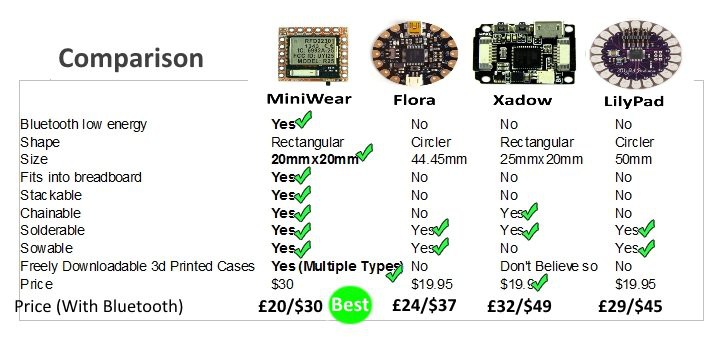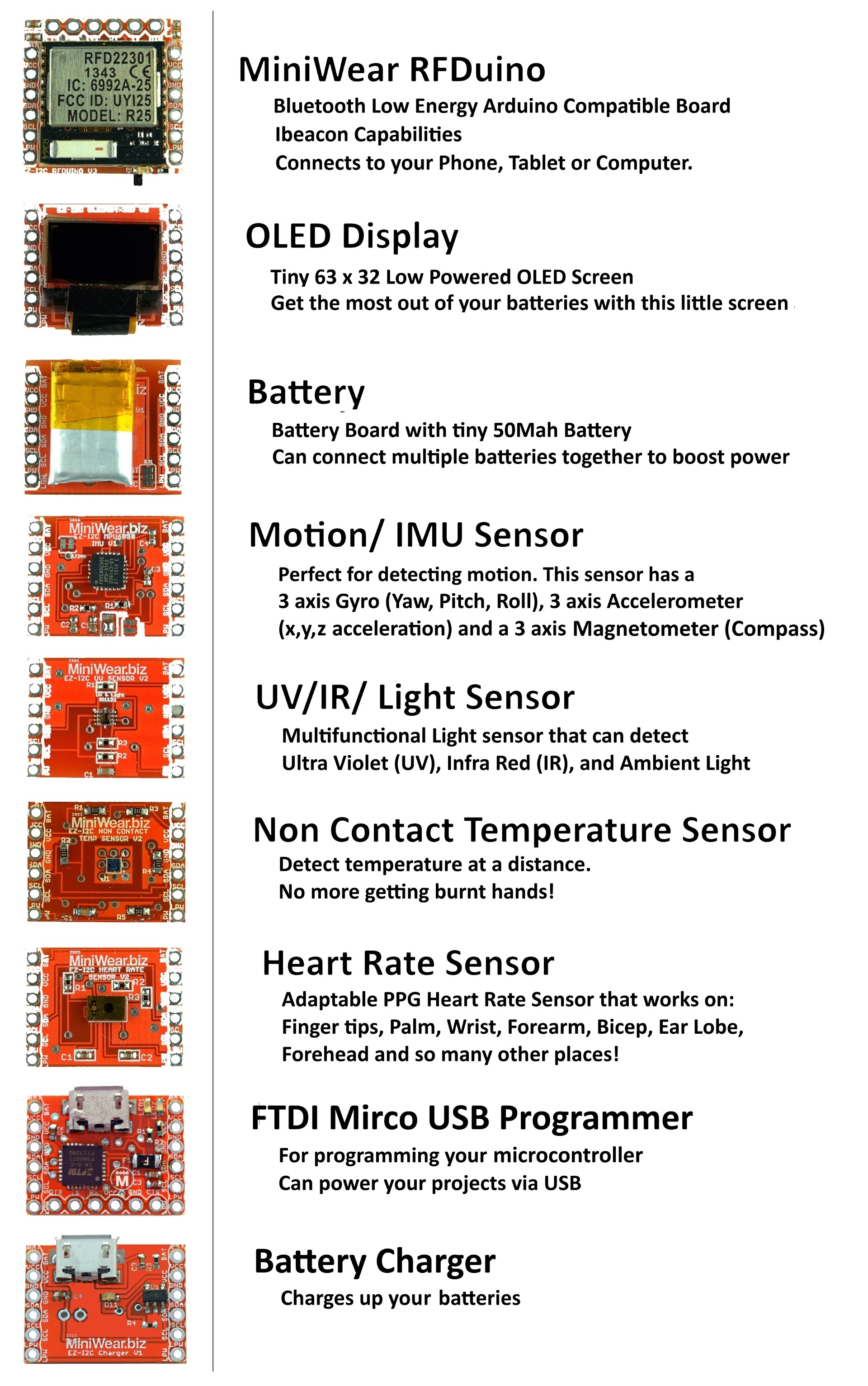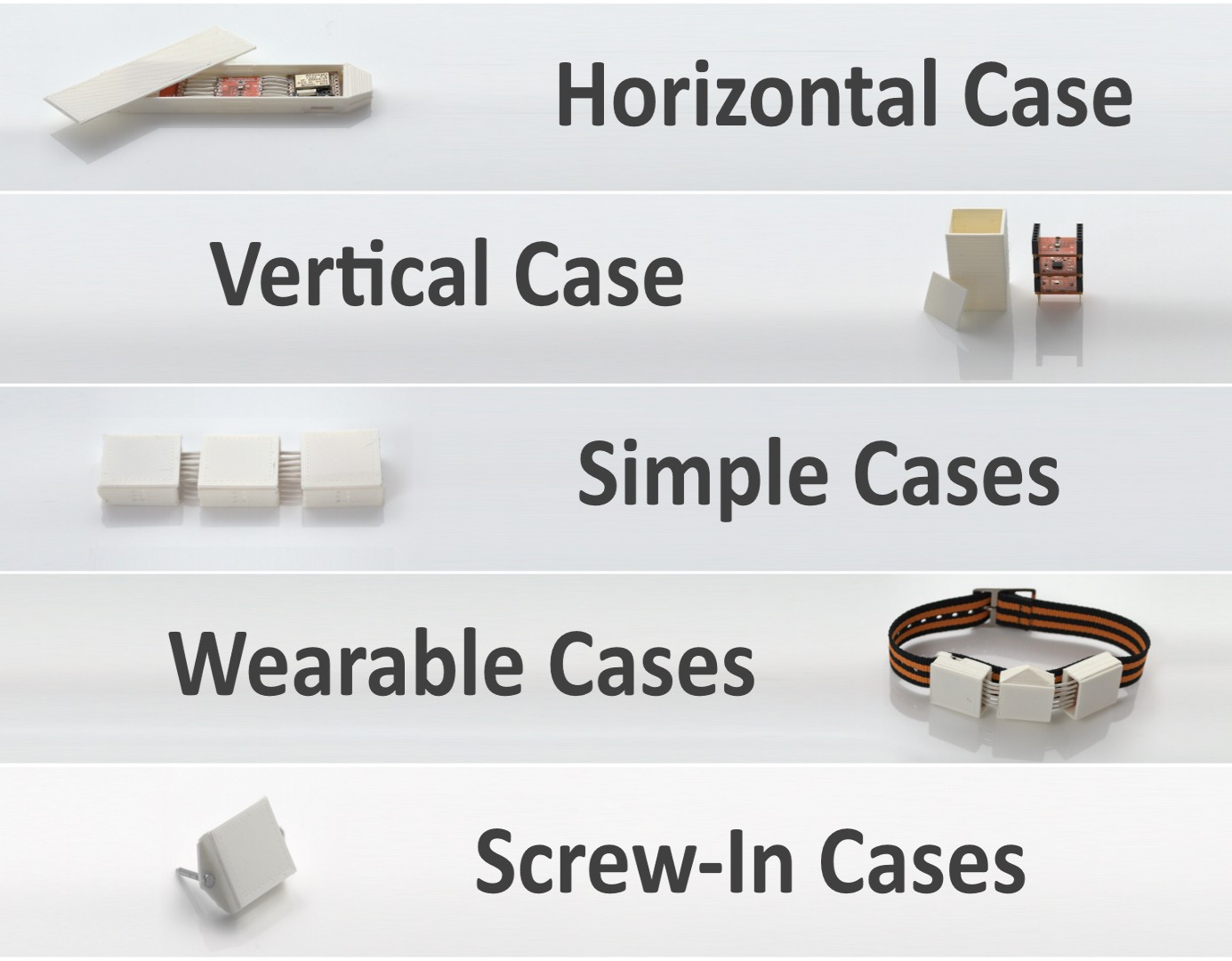Key benfits of MiniWear are:
- Open source
- Modular Electronics
- Supporting the maker movement
- Combines 3d printing with DIY miniature and wearable electronics
- Electronics modules can be stacked, daisy chained, sown, soldered and will fit into a standard breadboard
- Sensor modules include: heart rate sensor, non contact temperature sensor, 9 axis motion sensor, and a UV, IR and light sensor.
- Some of the smallest electronics on the market, measuring less than 2cm X 2cm (0.79” X 0.79”)
- Arduino based bluetooth low energy microcontroller with ibeacon capabilities
- Can communicate with your computer, tablet or phone
- Uses I2C to communicate to modules (Only needs 4 pins: VCC, GND, SDA, SCL)
Why Is It Better Than Other Wearable Boards?
MiniWear is the smallest development platform, with the most possible ways of connecting modules together, and still fits into a solderless breadboard. Making it a great platform to develop with. The range of freely downloadable cases is also a major plus, not to mention that it is the best value microcontroller if you are interested in using bluetooth low energy to connect to you computer, laptop, tablet or phone. If you don't need bluetooth, then i recommend that you try one of the other boards listed above.
Current Electronics Modules
These are some of the smallest modules around, measuring less than 2cm X 2cm (0.79" X 0.79"), and so are perfect for miniature and wearable projects. I have also chosen some of most interesting sensors i could find, from heart rate sensing to measuring temperature at a distance. The addition of the RFDuino Bluetooth Low Energy (BLE) module and the OLED screen gives you so many possible project options.
Every module can be connected to almost any microcontroller, such as Arduino's, PIC's, and Mbeds. This is because each module uses I2C for communication, which is easy to use once you know what your doing, and it only uses 2 pins (SDA & SCL) plus the standard power and ground pins. This allows me to make the modules as small as possible, and yet still be able to attach them in hundreds of different configurations.
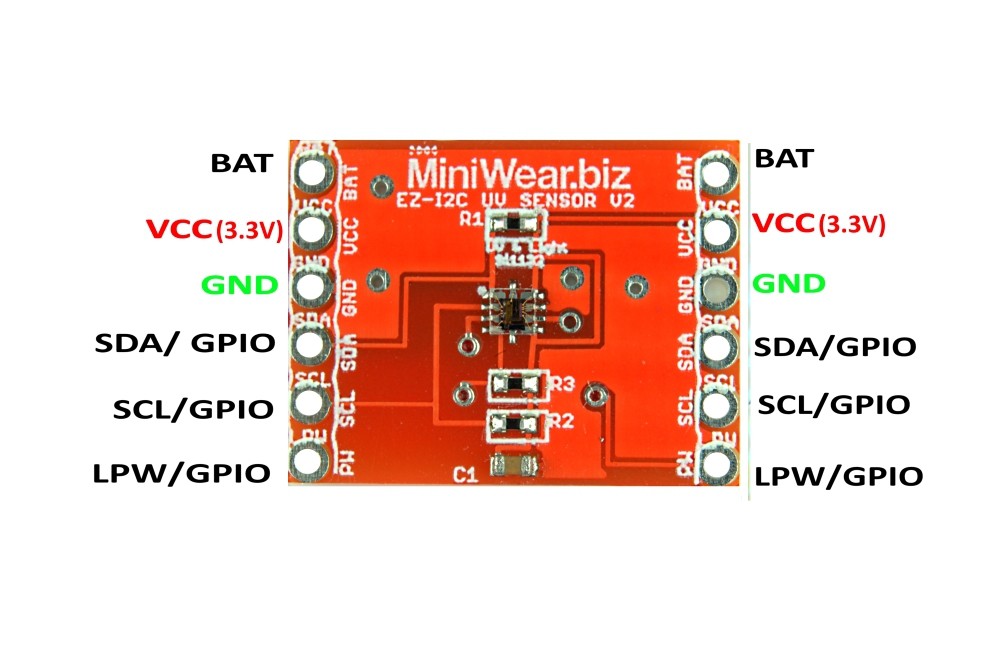
The MiniWear modules have 6 pins in total, the 2 required for I2C, 1 Ground, 1 Power, 1 extra general purpose pin that i have labelled LPW in case of extra Low PoWer modes (but it can be used for anything). There is also a BAT pin, which batteries are attached to so that i can add multiple batteries, regulate their power centrally, switch them all on/off, and recharge them all at the same time. It also opens up the possibility for alternative power modules in the future.
Every module is powered by 3.3V and has two sets of identical pins, this makes it super easy for connecting the modules together. Each module is also exactly the same width, and when combined with special headers, they can be connected in many different configurations, giving you many options for your projects.

How To Connect The Electronics Together?
Make Your Projects Look Cool With 3d Printed Cases
To take your projects to the next level and make your friends, family, teachers and colleagues amazed at your creative genius :) I have designed cases that you can download and print on your 3d printer, or order from a 3d printing service. These are absolutely free to download and alter so that you can use them as a base to create any style case you want: Fashionable, Functional or high tech, its up to you!
MiniWear Module Details
MiniWear BLE RFduino - The MiniWear RFduino is a Bluetooth 4.0 Low Energy BLE RF Module that easily connects to our sensor modules, and is compatible with the Arduino IDE and programming language. It has a built in temperature sensor, and i have added a 3.3V regulator so that you can power it with up to a 5.5V maximum. There is also a red LED to test that your projects are working, and i have added the ability to program the RFduino using a standard FTDI board, which is commonly used to program Arduino modules.
If you don't want to use I2C for communication, the pins can be reconfigured for GPIO i.e. digital or analogue use (ADC, PWM). The LPW pin is also GPIO which gives you more options for your projects.
Connects to many devices.
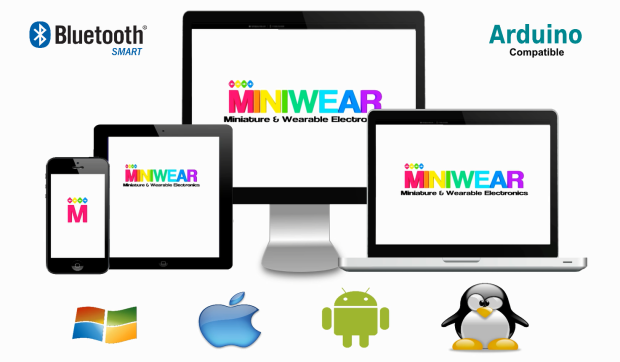
Compatible devices - Computers, Tablets & Phones
The MiniWear RFduino can send information to your computer, ipad, tablet or phone, but you need to make sure they are Bluetooth Low Energy (BLE) compatible. A list of compatable BLE devices can be found here: http://www.bluetooth.com/Pages/Bluetooth-Smart-Devices-List.aspx. Generally most phones nowadays are supported, but you should be careful with older phones.
The RFduino supports iBeacon (Explanation video can be found here) which can provide location awareness to your phone, tablet or laptop. Allowing them to know where they are, so they can perform actions like, go to silent, display information, or notify you about the latest deals when entering a room or shop.
The RFduino also has the special ability to wireless talk to another RFduino, which gives you a lot more freedom when designing your projects.
The RFduino is FCC, IC & CE approved so that you can easily add it to your own commerical projects.
Specs
Name
MiniWear RFduino
CPU
16MHz ARM Cortex-M0
Flash
128kb
Ram
8kb
Supply Voltage
2.7V - 5.5V
Transmit Current / Receive Current
18mA
FCC Approved & ETSI -CE Tested
Yes
Transmit Power
4dbm
Size (mm)
19.84(L) x 19.30(H) x 1.6(D)
Battery Module - Uses a mini lipo plug making it very easy to connect almost any battery you like. I like to use a really tiny 3.7V 50mah battery which is perfect for wearable applications. The good news is that i have added extra pin holes so that you can connect any battery you want, or connect many battery modules together to make your projects last even longer.

The 9 Axis IMU (Motion) Sensor Module - Uses the MPU9250 chip that includes a 3 axis gyro, 3 axis accelerometer and a 3 axis magnetometer. This is an upgrade to the very popular MPU9150 sensor module, and gives you a lot of options for your motion projects including: Balancing, Virtual Reality (VR), Drone and Robotic Control projects.
- Gyro has a full-scale range of ±250, ±500, ±1000, and ±2000dps
- Accelerometer has a full scale range of ±2g, ±4g, ±8g and ±16g
- Tri-axis compass with a full scale range of ±4800µT
- Operating currents: Full Chip Idle mode = 8uA, Gyro = 3.2mA, Accel = 450uA, Mag = 280uA, Gyro + Accel = 3.4mA (accel at 1kHz sample rate), Gyro + Accel + Compass = 3.7mA (Gyro at 1khz, accel at 4kHz sample rate, compass at 8Hz rate)

IMU Projects
UV, IR & Light Sensor Module - Is a very interesting multi-functional module that can measure Ultra Violet, Infra Red and Ambient light. It uses less than 500nA standby current and an average power of as little as 1.2 uA with once per second real-time UV Index measurements. This is a brilliant little sensor that can be used for detecting when a room is light, dark or anywhere in-between. It also contains a IR sensor which makes a great distance sensor when joined with an IR LED. While the UV sensor is perfect for detecting harmful UV rays from the sun, which means you will know when you need to put on sun cream or when to stay in the shade. The sensor could also be used to tell you if you have had your recommended daily allowance of sunlight, which will help people take care of their skin, Vit D intake and even depression.

Non Contact Temperature Sensor Module - is a fun thermopile sensor that uses the TMP007 chip to detect temperature at a distance by absorbing infra-red light. The sensor can detect temperature anywhere from -40C to 125C. You can use it to detect hot/cold water, hot cups, hot pans, hot machines or count people walking by, but i like to use it for measuring skin temperature.

Heart Rate Sensor Module - is an advanced module with built in adaptability to compensate for different skin colours, and can be used on your finger tips, ears, forehead, forearm, bicep and probably most other places. This is a great little module and is super useful for health applications. It is based on optical technology which measures the variation of human blood vessels, which is called Photoplethysmography (PPG). The sensor is not a medical device and needs good contact with the skin, but can detect heart rates anywhere from 30 to 210 beats per minute (BPM) with a tolerance of +-3bpm at room temperature when in a steady (no motion) state.

[Heart Rate Graph & Tested Sensor Positions]
OLED Screen Module - is the perfect partner to any project and opens up so many amazing projects. Get notifications from your computer, tablet or mobile, such as who is calling, missed calls, text messages, alarms etc... or it can be used to tell you about the attached sensors such as temperature, heart rate, UV index, light level or simply tell you the time. This is also one of the best screens (Other than epaper) for battery and low powered projects as it only uses 1-10uA in sleep mode and 5mA (max 15mA) when active.

Support
If you like the project, and fancy supporting, perhaps you wouldn't mind supporting me on Patreon? Every little bit helps me release more great projects, which helps fuel the amazing open source community. Even $1 makes a difference :)
What Is Next?
If you have a few seconds i would really love to hear what you think about MiniWear, especially ways i could improve it.
 James Cannan
James Cannan